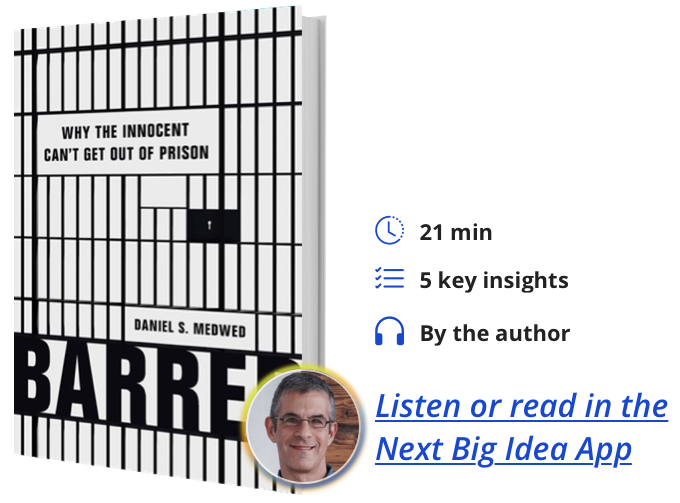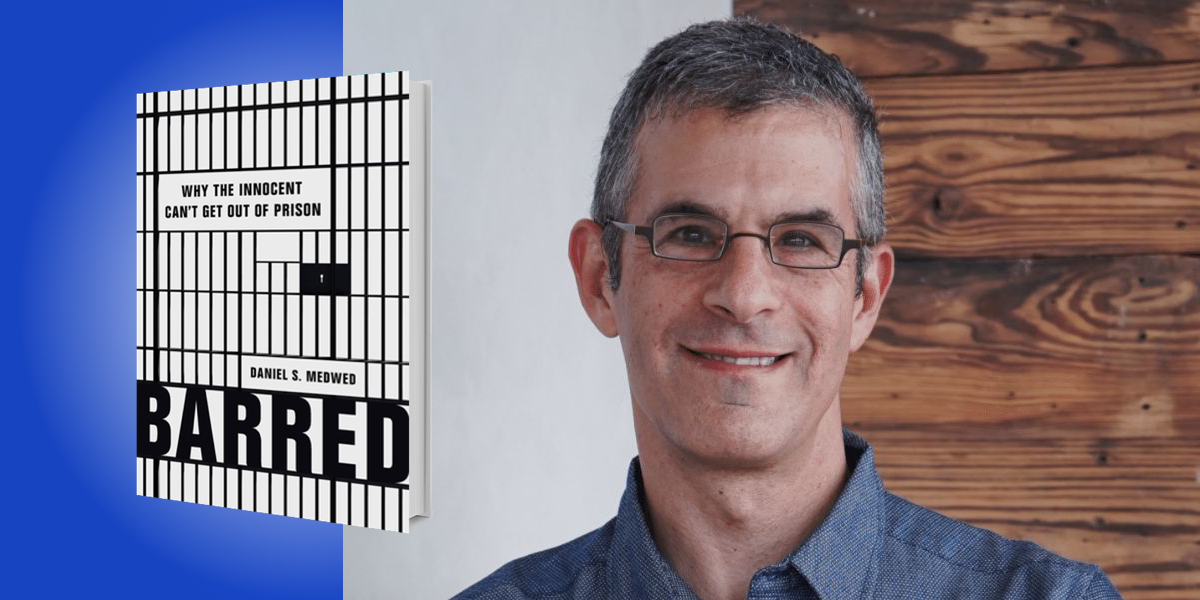Daniel Medwed is university distinguished professor of law and criminal justice at Northeastern University School of Law and on the Board of the New England Innocence Project. Prior to joining Northeastern, Medwed taught at the University of Utah S. J. Quinney College of Law and at Brooklyn Law School, where he oversaw its Second Look Program that investigated and litigated claims of innocence by New York inmates.
Below, Daniel shares 5 key insights from his new book, Barred: Why the Innocent Can’t Get Out of Prison. Listen to the audio version—read by Daniel himself—in the Next Big Idea App.

1. The trial is a vanishing species.
There are just enough high-profile criminal trials to give the impression that heated courtroom battles over guilt or innocence are the norm. Think O.J. Simpson, Dzhokhar Tsarnaev, or Derek Chauvin. In truth, the criminal trial is a vanishing species, a casualty of the steady rise of plea bargaining.
It makes sense why plea bargaining has displaced the American trial as the main mechanism for resolving criminal charges. Guilty pleas streamline the litigation process and suit the needs of prosecutors obsessed with conviction rates, overworked defense attorneys, risk-averse defendants, and neglectful judges tasked with managing jam-packed dockets. Defense lawyers and prosecutors tend to negotiate pleas quickly, lives and liberty bartered away by harried attorneys speaking in hushed tones. Prosecutors often demand that to get a plea bargain, defendants must not only forsake their right to trial, but also waive their right to challenge any underlying legal issues in their case later on in an appellate tribunal.
The defendant then appears in court to ratify the deal. At that hearing, the defendant admits guilt, briefly testifies about the facts of the crime, and claims he knows what he’s doing in entering the agreement and giving up his rights. A judge accepts the guilty plea and imposes the negotiated sentence, which is typically a fraction of the maximum sentence facing the defendant if the case went to trial. Justice signed, sealed, and delivered in a matter of minutes. The upshot? Approximately 95 percent of criminal cases are resolved through plea bargaining, a percentage that’s gone up since the “tough‑on‑crime” era of the 1980s.
However, the purported advantages of plea bargains wither on closer examination, especially for the innocent. Prosecutors, not judges and juries, dictate the outcomes of cases by crafting plea offers on their own that effectively determine defendants’ fates. Also, defendants aren’t privy to all of the evidence in the prosecutor’s files and therefore are poorly positioned to weigh the pros and cons of going to trial. Ultimately, if they make a bad decision and plead guilty, it’s incredibly difficult to overturn that decision down the line, unless there’s a blatant defect in the plea proceeding itself. Some states even make clear that a claim of actual innocence is not an adequate basis for toppling a plea.
“Approximately 95 percent of criminal cases are resolved through plea bargaining.”
This state of affairs creates a terrible quandary for defendants. Take the deal and sacrifice your right to a trial, or roll the dice and potentially receive a much stiffer punishment. What’s gained in this process is efficiency and finality. What’s lost is a public reckoning and a thorough accounting of the facts in an open forum. And what’s unknown is whether the defendant is actually guilty.
2. The appeal is not a good vehicle for exposing innocence.
Say an innocent suspect is charged with a crime, refuses to plead guilty, and goes to trial. Assume these hopes are naive. The jury returns a guilty verdict. It takes a lot to reverse a case after a defendant has lost at trial and exercised the right to challenge the conviction in a higher court, a process known as the direct appeal.
Although every state grants this right, the direct appeal lacks the stature of the trial within the litigation hierarchy. As the Supreme Court observed in a 2017 case “The criminal trial enjoys pride of place in our criminal justice system in a way that an appeal from that trial does not. The Constitution twice guarantees the right to a criminal trial . . . but does not guarantee the right to an appeal at all. The trial ‘is the main event at which a defendant’s rights are to be determined.’”
The fact that the appeal is viewed as the undercard to the system’s main event, the trial, is manifested in the rules that govern the appellate process. For instance, the defendant is confined to the trial record in raising claims on appeal. Even then, not every potential claim is recognized on appeal—only those that are what’s known as “preserved.” A claim is preserved, and eligible for a close look on appeal, if the defense lawyer raised it with the trial judge and discussed it thoroughly.
There are two main rationales for the preservation requirement. The first is efficiency. We want legal issues vetted and resolved at trial. The preservation doctrine incentivizes lawyers to lay their cards on the trial table, maximizing the likelihood justice will be served in that phase. If you object, maybe the judge will agree and there will be no need to appeal it at all. She also may overrule the objection, set forth the grounds of her decision, and leave a trail of breadcrumbs for the appeals court to follow in evaluating it.
“The fact that the appeal is viewed as the undercard to the system’s main event, the trial, is manifested in the rules that govern the appellate process.”
Second, there’s the need to deter “sandbagging,” the purposeful withholding of a legal argument at trial in order to save it for a potential appeal. Suppose a lawyer is worried about objecting too much and coming across as well, objectionable to the jury. Without the preservation requirement, she might hold back on an objection, keeping her views secret. If things go sideways and her client is convicted, the defendant could still try to argue the issue for the first time on appeal. That kind of gamesmanship is simply inconsistent with fair play.
The downside of preservation is that it makes appellate lawyers dependent on the skills and tactical decisions of the defense attorney who handled the case originally. Preservation also constrains the ability of appeals courts to aid an innocent prisoner.
3. Other post-conviction remedies aren’t much better than the direct appeal.
Losing the direct appeal is not the end of the road for the innocent prisoner. There are also so-called collateral or “post-conviction” remedies that attack a case indirectly, with new arguments or new evidence, rather than launching a targeted challenge to exactly what happened in the trial court, which is the purpose of the direct appeal.
One of them is the writ of habeas corpus, a litigation option borrowed from England. A habeas corpus filing asks government officials to justify why they “have the body” in custody. If no sound reason surfaces, the court may issue a writ, which is an order to release that person. The problem here is courts have normally treated habeas corpus as a vehicle to correct constitutional or jurisdictional mistakes, not to address claims of innocence. In fact, the Supreme Court has indicated that a “bare” or freestanding innocence claim is not even enough to get habeas review.
A second post-conviction remedy, which derives from another ancient writ known as “coram nobis” is theoretically designed to grapple with fact-based questions of innocence but, all too often, fails to do that in practice. Coram nobis translates to “before us”; it allows a prisoner to go back to their trial judge, put forth new evidence that undermines confidence in the conviction, and ask for a new trial. As we saw in the Bobby Fennell case from New York, though, coram nobis doesn’t always live up to its promise. Stingy visions about what comprises “new” evidence and how much “new” evidence is required to warrant a new trial make it less valuable than one might think in proving innocence. On that note, the litigation process itself may be less valuable than other processes in seeking to overturn a wrongful conviction.
4. Parole and clemency are ill-fitting suits for the innocent.
If courts truly cared about innocence, the procedures governing such claims wouldn’t be so burdensome. Full and fair airings of new evidence would happen more often, exonerations granted more readily, and faith in our criminal justice system restored more broadly.
The courts don’t play the only role in righting wrongs. The executive branch also has opportunities to look at possible wrongful convictions through the tools of parole and clemency. Prisoners released on parole remain under state supervision albeit outside their cells for the rest of their sentence. Clemency, in turn, covers a range of things, mostly notably a “pardon” in which the government forgives the offense and wipes an inmate’s slate clean or a “sentence commutation” which is when the state shortens or commutes a prison sentence.
“The courts don’t play the only role in righting wrongs.”
These executive remedies are poor mechanisms for reversing wrongful convictions, but for reasons different than the ones that plague the courts. Parole and clemency are all about extending mercy, offering forgiveness to a prisoner deserving of a break. As a result, parole and clemency boards tend to demand an admission of guilt, an acceptance of responsibility, as a prerequisite for receiving mercy. This puts prisoners in a bind, also labeled the “Innocent Prisoner’s Dilemma.”
Option A: feign guilt to increase the chance of parole and clemency, while harming the chance for exoneration in court through the creation of an inculpatory statement on the record.
Option B: Stick to your guns and maintain innocence and, in the process, basically doom your prospects for freedom in the short term.
Both of these options are suboptimal for the innocent and outcomes reflect this reality.
5. A new model for evaluating innocence claims could come through “Innocence Commissions.”
As you know by now, existing judicial and executive branch remedies are not up to the task of freeing the innocent, even when faced with powerful evidence that the system has made a grievous mistake. We could tinker around the edges of these procedures to boost the odds of achieving justice. We could also consider a more dramatic change, one that is in use in the United Kingdom and in a single U.S. state, North Carolina. We could create “Innocence Commissions” in every state, working as independent agencies with the power and funds to investigate claims of actual innocence and refer the most meritorious of those claims to the courts.
Under this model, prisoners apply to the commissions for assistance; investigators then take a deep dive into the case; if the innocence claim seems valid after an exhaustive look, then cases would be sent to judges. With the imprimatur of the Commission’s approval, judges would presumably take these cases very seriously.
To be sure, this is not a cure to our system’s many ills. Innocent prisoners will invariably slip through the cracks of the Commission process, and it’s possible that courts will overvalue Commission decisions to the point where these entities effectively are both judge and jury, with little to no accountability.
Still, by creating nonpartisan specialists in the area of actual innocence, and giving them money to investigate, we could better separate strong claims from the weak ones. Given the current failings of the criminal justice system that strikes me as a big idea well worth pursuing.
To listen to the audio version read by author Daniel Medwed, download the Next Big Idea App today:































